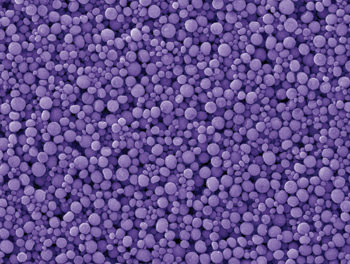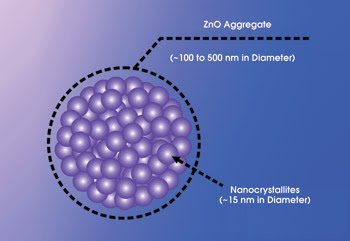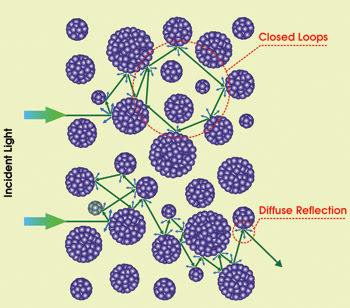Researchers turn to zinc oxide as an alternative low-cost, high-efficiency material for dye-sensitized solar cells.
Guozhong Cao, University of Washington
The sun, as the primary source of energy for all organisms on Earth and as a carbon-neutral power source, is considered the ultimate solution to the environmentally friendly energy challenge. In one hour, the sun deposits 13.6 TW of radiation on the Earth — more energy than is consumed in a whole year (13 TW). Solar cells, also known as photovoltaics, are devices that convert sunlight into electricity.

Tiny popcorn-style material makes up dye-sensitized solar cells.
Crystalline silicon semiconductor solar cells, invented more than 50 years ago, currently make up 94 percent of the market; however, high cost limits their widespread use. Although second-generation solar cells are advancing rapidly and have the potential to match or surpass the performance of single-crystalline silicon at reduced cost, meeting the long-term goal of low cost ($0.4/kWh) and high efficiency (more than 32 percent) will require major breakthroughs in materials science and in cell design.
In the early 1990s, a new class of dye-sensitized solar cell, which is similar to a traditional electrochemical cell, showed power conversion efficiency of more than 4 percent, with titanium dioxide (TiO2) used as the electrode. This material has a wide bandgap (3.2 eV) and is an inexpensive semiconductor. The key electrode consists of a film with a high porosity — about 50 percent — made of TiO2 nanoparticles of 15 to 20 nm in diameter. The 10-μm-thick electrode has a specific surface area of ~100 m2/g and pores of about 20 nm. A self-assembled monolayer of dye molecules is on the inner surface of the film.
When illuminated, the dye molecules capture the incident photons and generate electrons and holes. The resultant electrons, at excited states, are immediately injected (within 100 fs) into the conduction band of TiO2 and transported to the electron-collecting electrode. Regeneration of dye molecules is accomplished by capturing electrons from the liquid electrolyte that fills the entire void space in the porous TiO2 electrode and that connects to the counterelectrode. Because of the simplicity of the device and the low cost of the TiO2, dye-sensitized solar cells have great potential for large-scale applications.
The power conversion efficiency is dependent on capturing photons, on generating electron hole pairs, and on transporting the electrons and holes separately out of the cells. Nanocrystals are critical to forming nanoporous electrodes with the desired surface area for the dye molecule adsorption. The more the dye molecules are adsorbed, the more photons can be captured, and the more electron hole pairs can be generated.
Because the traveling distance of electrons is approximately 10 μm, increasing the thickness of nanoporous electrodes will not improve the power conversion efficiency. Mixing submicron-size particles into nanoporous electrodes can effectively increase the traveling distance of photons within the electrode as a result of light scattering and thus can enhance the probability of photon capturing. However, incorporating such large particles results in decreased surface area; thus, fewer photon-capturing dye molecules can be adsorbed. Consequently, the enhancement by light scattering is compromised by the decreased number of dye molecules, and power conversion efficiency is not increased.

Figure 1. This schematic diagram illustrates the detailed microstructure of submicron-size aggregate, or popcorn, consisting of closely packed primary ZnO nanosize crystallites.
ZnO nanocrystallites
Recently we fabricated popcorn-style dye-sensitized solar cells (Figure 1). Their porous electrodes were made of submicron-size aggregates (or popcorns) of zinc oxide (ZnO) nanocrystallites and demonstrated significantly enhanced power conversion efficiency.1 In this approach, ZnO nanocrystallites ensure the desired surface area for dye molecule adsorption, and the submicron-size aggregates serve as the light scatterers without sacrificing the specific surface area (Figure 2). Zinc oxide is another wide-bandgap semiconductor oxide with the same electronic structure but with higher electron mobility than TiO2.

Figure 2. Shown is the hypothesized propagation and multiple scattering of light in a porous electrode consisting of submicron-size aggregates of ZnO nanocrystallites.
ZnO is easier and cheaper to synthesize into various nanostructures than TiO2 is and thus is a viable electrode candidate for dye-sensitized solar cells. As a result of light scattering, the power conversion efficiency has been increased from 2.4 percent with an ordinary porous electrode made of dispersed nanocrystallites to 5.4 percent with that made of submicron-size aggregates with all the other parameters kept the same. When the other parameters are adjusted further, power conversion efficiency of 6.2 percent has been achieved. The formation of submicron-size aggregates or “popcorns” is the result of the controlled collapse of the double-layer structure along the surface of the surrounding electrolyte solution.
It should be pointed out that the power conversion efficiency of 6.2 percent in popcorn-style dye-sensitized solar cells is still lower than the best achieved in TiO2 ones — largely because of the poor chemical stability of ZnO nanocrystallites in electrolyte solutions that prevents the formation of a quality monolayer of dye molecules. Power conversion efficiency higher than 11 percent is anticipated when the popcorn structure is successfully transferred to TiO2 dye-sensitized solar cells or when the ZnO surface chemistry stability is improved, and several strategies are under study by our group.
Reference
1. Q.F. Zhang et al (2008). Aggregation of ZnO nanocrystallites for high conversion efficiency in dye-sensitized solar cells. Angew Chem Int Ed, Vol. 47, pp. 2402-2406.
Meet the author
Guozhong Cao is a professor in the department of materials science and engineering at the University of Washington in Seattle; e-mail: [email protected].